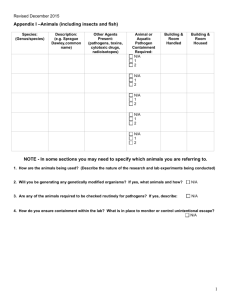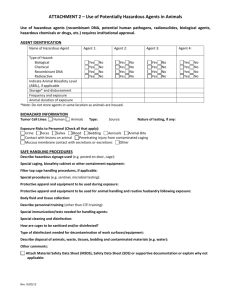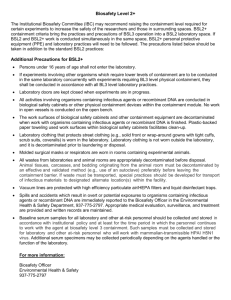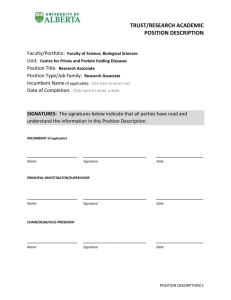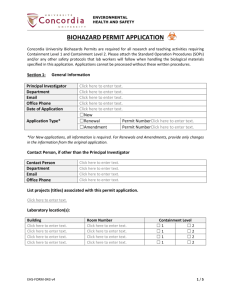doc - York University
advertisement
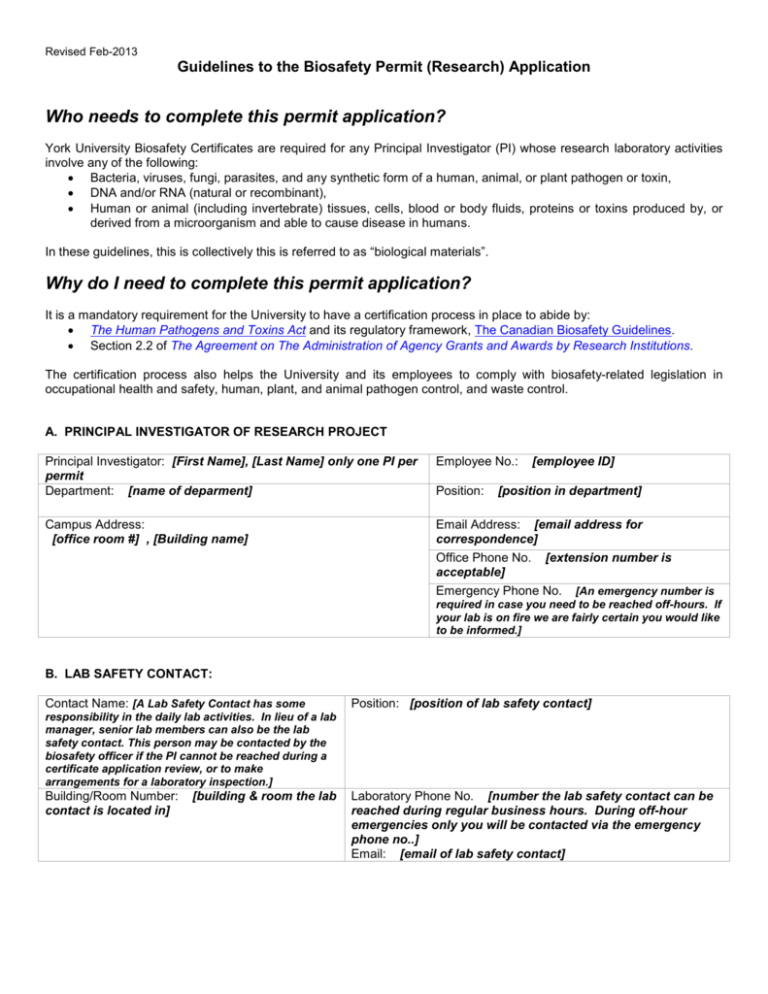
Revised Feb-2013 Guidelines to the Biosafety Permit (Research) Application Who needs to complete this permit application? York University Biosafety Certificates are required for any Principal Investigator (PI) whose research laboratory activities involve any of the following: Bacteria, viruses, fungi, parasites, and any synthetic form of a human, animal, or plant pathogen or toxin, DNA and/or RNA (natural or recombinant), Human or animal (including invertebrate) tissues, cells, blood or body fluids, proteins or toxins produced by, or derived from a microorganism and able to cause disease in humans. In these guidelines, this is collectively this is referred to as “biological materials”. Why do I need to complete this permit application? It is a mandatory requirement for the University to have a certification process in place to abide by: The Human Pathogens and Toxins Act and its regulatory framework, The Canadian Biosafety Guidelines. Section 2.2 of The Agreement on The Administration of Agency Grants and Awards by Research Institutions. The certification process also helps the University and its employees to comply with biosafety-related legislation in occupational health and safety, human, plant, and animal pathogen control, and waste control. A. PRINCIPAL INVESTIGATOR OF RESEARCH PROJECT Principal Investigator: [First Name], [Last Name] only one PI per permit Department: [name of deparment] Employee No.: Campus Address: [office room #] , [Building name] Email Address: [email address for correspondence] Position: [employee ID] [position in department] Office Phone No. acceptable] [extension number is Emergency Phone No. [An emergency number is required in case you need to be reached off-hours. If your lab is on fire we are fairly certain you would like to be informed.] B. LAB SAFETY CONTACT: Contact Name: [A Lab Safety Contact has some Position: [position of lab safety contact] responsibility in the daily lab activities. In lieu of a lab manager, senior lab members can also be the lab safety contact. This person may be contacted by the biosafety officer if the PI cannot be reached during a certificate application review, or to make arrangements for a laboratory inspection.] Building/Room Number: contact is located in] [building & room the lab Laboratory Phone No. [number the lab safety contact can be reached during regular business hours. During off-hour emergencies only you will be contacted via the emergency phone no..] Email: [email of lab safety contact] Revised Feb-2013 Biosafety Office Use Only Project Number: C. RESEARCH GRANT INFORMATION (attach additional sheets, as required) Applicant Name(s): Project Title: [In cases of joint grant submissions, list all persons who applied/areapplying for the grant] [title of grant] All Funding Sponsor or Agency Name(s): [acronyms are acceptable] Date of Application: [date grant was awarded or date grant application was submitted] Funding Period: [period of grant award] Project Description- A lay summary of the project and an outline of how the biological agents/materials are handled and analyzed in the lab to achieve project goal (point-form summary acceptable): [point form summary is encouraged] D. PROJECT LOCATION(S)/CONTAINMENT LEVEL (CL) Building Room Number Or Floor/Bench# Room Use (e.g. main lab, culture room, Vivaria) CL (1-2) Is this a shared lab space? Name of PI(s) in Shared Lab Space. (Do not list if in LSB) list all rooms of your lab including where your biological material is stored (eg walk-in cold rooms, fridge areas). Please indicate if you share the space with more than one Primary Investigator. For more information on Risk Groups and Containment Levels (CL) please refer to page 4 and 5. E. BIOLOGICAL SAFETY CABINET(S) Make Serial Number Building Room If shared, name of other PI sharing cabinet Please indicate if any other labs share your BSC F. HUMAN, ANIMAL AND/OR RADIATION USAGE WITH BIOLOGICAL AGENTS/MATERIALS Human Subjects: [Self-explanatory] Animal Usage: [If tissues in the lab are obtained from research animals whose use requires approval from the York University Animal Care Committee (YUACC), this must be indicated. This is also true for animals that are used in conjunction with biological materials. A copy of the YUACC approval letter and completion of Appendix I is required. If animal tissues are used that do not require approval through the YUACC (e.g. insects), this must also be indicated and Appendix I must be completed.] Radiation Usage: [Radioisotopes and any other form of radiation used in conjunction with the biological materials in the certificate also require an attached copy of approval documentation.] Revised Feb-2013 G. EXTERNAL REGULATORY AGENCY/INSTITUTIONAL APPROVAL OR PERMIT If you have an import permit from the Public Health Agency of Canada or the Canadian Food Inspection Agency, your lab is more likely to be federally inspected. Making the biosafety office aware of your permits will allow us to assist you in ensuring your lab is in compliance with the relevant regulations. H. BIOSECURITY Describe measures taken to secure the biological agent/materials from unintentional use (e.g. theft): visit http://www.yorku.ca/safety/index.html and http://www.yorku.ca/security/safetytips.htm for more information. I. EMERGENCY RESPONSE What are your emergency response procedures? visit http://www.yorku.ca/epp/ for more information. or http://www.yorku.ca/dohs/prog-biosafety.html J. ANIMAL/BIOLOGICAL AGENTS/MATERIAL INVENTORY/USAGE AND RISK GROUP CLASSIFICATION Make sure to fill out the proper appendices. K. PERSONNEL INCLUDING THE PRINCIPAL INVESTIGATOR Your lab members must sign the document. J. IMMUNIZATION M. DECLARATION Be sure to sign the Declaration to avoid permit issuing delays Revised Feb-2013 What are risk groups? By completing the application, you are conducting a risk assessment of the biological materials used in your lab. Your risk assessment is then reviewed (or reassessed) by members of the York University Biosafety Committee (YUBC). Four risk group categories are used: Risk Group 1 (RG-1) low individual and community risk Any biological agent that is unlikely to cause disease in healthy workers or animals. Risk Group 2 RG-2 (moderate individual risk, limited community risk) Any pathogen that can cause human or animal disease but, under normal circumstances, is unlikely to be a serious hazard to healthy laboratory workers, the community, livestock or the environment. Laboratory exposures rarely cause infection leading to serious disease. Effective treatment and preventive measures are available and the risk of spread is limited. Risk Group 3 (RG-3) high individual risk, low community risk Any pathogen that usually causes serious human or animal disease, or which can result in serious economic consequences but does not ordinarily spread by casual contact, from one individual to another, or that can be treated by antimicrobial or antiparasitic agents. Risk Group 4 (RG-4) high individual risk, high community risk A pathogen that usually produces very serious human or animal disease, often untreatable, and may be readily transmitted from one individual to another, or from animal to human or vice-versa, directly or indirectly, or by casual contact. Risk groups are somewhat straightforward when assessing microorganisms, but may not be immediately obvious when dealing with other biological materials (e.g. blood, tissues, cell lines). To assign an appropriate risk group, one must consider the most dangerous pathogens/agents that could potentially be harbored in the biological material being assessed. Even materials coming from apparently healthy donors must be considered in the same manner. A list of some microorganisms and toxins classified into risk groups can be found in the Human Pathogens and Toxins Act (HPTA), Schedules 1-4. Examples of risk groups for common biological materials: Escherichia coli Escherichia coli K12 derivatives Staphylococcus aureus Human blood Human established cell line, HEK 293 Rat, skeletal muscle tissue Rat, muscle tissue, primary cell culture RG-2 RG-1 RG-2 RG-2 RG-2 RG-1 RG-1 What are Containment Levels? Once the biological materials have been identified, one must determine the appropriate measures that should be in place to keep it “contained”. These are classified into containment levels one to four, and address the engineering, operational, technical, and physical requirements for manipulating the biological material. York University does not have the appropriate facilities for containment level three or four labs. Containment Level One (CL-1) Requires no special design features beyond those suitable for a well-designed and functional laboratory. Biological safety cabinets (BSCs) are not required. Work may be done on an open bench top, and containment is achieved through the use of practices normally employed in a basic microbiology laboratory. Containment Level Two (CL-2) The primary exposure hazards are through ingestion, inoculation, and mucous membrane route. Agents requiring CL-2 facilities are not generally transmitted by airborne routes, but care must be taken to avoid the generation of Revised Feb-2013 aerosols or splashes. Primary containment devices such as BSCs and centrifuges with sealed rotors and safety cups are to be used as well as appropriate personal protective equipment. As well, environmental contamination must be minimized by the use of handwashing sinks and decontamination facilities (autoclaves). When determining a containment level for each biological material: Consider the assigned risk group and how it will be manipulated in the lab Consider all steps in a procedure where exposure is most likely (e.g. where aerosols are generated, or if the quantity or concentrations of materials is high), and mitigate the risk accordingly (e.g. working in a biological safety cabinet). The highest containment level required for the materials assessed will be declared on the certificate. Examples of containment levels for common biological materials: Lab-strain E.coli (e.g. DH5α, TOP10) Human blood Human established cell line, HEK 293 Rat, skeletal muscle tissue Rat, muscle tissue, primary cell culture CL-1 CL-2 CL-2 CL-1 CL-2 References Public Health Agency of Canada (PHAC) Laboratory Biosafety Guidelines (LBG): www.phac-aspc.gc.ca/publicat/lbg-ldmbl-04/index-eng.php PHAC Material Safety Data Sheets (MSDSs) for infectious substances: www.phac-aspc.gc.ca/msds-ftss/ Canadian Food Inspection Agency (CFIA) Containment Standards for Veterinary Facilities: (Animal pathogen (AP) containment levels and requirements for working with animal pathogens) www.inspection.gc.ca/english/sci/lab/convet/convete.shtml CFIA, Containment standards for facilities handling plant pests: www.inspection.gc.ca/english/sci/bio/plaveg/placone.shtml
